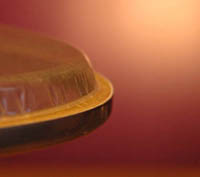Basics and Objectives of Drum Tuning
Tuning is a purely mechanical exercise and therefore there are many varied ways of delivering an appropriate tone from a drum. The choice of tones, timbres and relative tensioning is a separate issue and discussed here.
The method that I advocate here is one that works for me, however I recommend you experiment and take other advice. Once you understand the principles the methods become apparent.
The materials
Drum heads are generally made from Mylar which is a plastic. Over a period of use, particularly with  batter or top heads, that plastic will heat and stretch or be forced out of shape by force as it absorbs the impact of a players’ strokes. When a drum head gets to the point that you either cannot tune to / maintain a single pure tone, or you physically disfigure the head, it is time to replace the heads.
batter or top heads, that plastic will heat and stretch or be forced out of shape by force as it absorbs the impact of a players’ strokes. When a drum head gets to the point that you either cannot tune to / maintain a single pure tone, or you physically disfigure the head, it is time to replace the heads.
Regardless of what type of head you are using or the quality of your kit, there is no point in trying to tune a drum kit that has old heads that have passed their best. Doing so is affectionately known as ‘turd polishing’
Resonant bottom heads don’t lose their tone as quickly, but they are still under tension and should be checked and replaced regularly, A reasonable rule of thumb might be to change resonant heads with every third or fourth change of batter heads.
To get the best out of your drums therefore you should use fresh heads. To really understand the tuning process and be able to hear the nuances of the skin telling you what it needs, you should work with single ply heads initially, I’m not suggesting that you use them for your playing, although many professionals do, but they are the best medium with which to illustrate the tuning process and to let you hear the voices of the drum as we move through that process.
The same fundamental tuning principles are applied to all drums in a drum kit; whether kick, snare or toms. Over & above that, bass drums & snare drums involve other considerations which we will address after looking at basic batter & resonant head tuning on toms.
The process takes much longer to read than it does to carry out, your first attempts may take a while but as you do it more & more it becomes easier and quicker. The results are instant. If you have any comments or questions please feel free to e-mail me
Plan of Action
- Shell integrity – Bearing edge check – shell twist or torsion check
- Fine tuning – the nitty gritty!
- Resonant heads – The secret to the full sound of your drumset
- Snare drum – Snare tuning
- Controlling and treating the sound –Muffling / drum treatment
- Creative tuning options – Tuning intervals & drum fundamental pitches